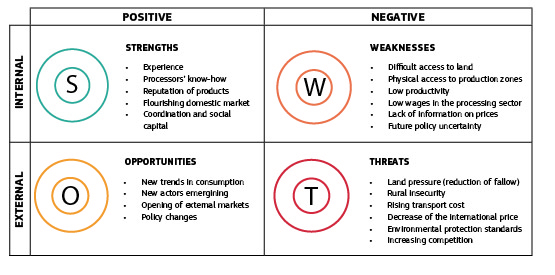1.1 The Functional Analysis
The functional analysis provides an overall description of the value chain system. It identifies the main actors and stakeholders involved, and expands on some of the main strategic development challenges faced. It allows the multidisciplinary team to elaborate a general common understanding of the VC operations, and to ascertain the scope of analysis. Essential elements include determining a typology of actors, the various sub-chains and the geographic and time frames, which form the basis of all the analyses in order to reply to the framing questions.
Key components in a value chain system are: the sequence of products, the actors involved, the functions they fulfil, the flows linking the actors and the overall organisation and governance of the VC.
The functional analysis encompasses three main areas:
- the main features of the value chain: identifying the key products, actors, functions, the geographical location of activities and operations, as well as the main flows (figure 1).
- the main technical processes and practises: main technologies used; technical coefficients and productivity ratios; benchmarking; main known physical and technological constraints and risks.
- the VC organisation and governance, overall and at every level: organisations, institutions, coordination schemes, business environment and policy framework.
Figure 1: Flow chart of a green beans value chain

VCA4D studies examine the operations of the VC only within the country, even when (part of) the VC production is exported. Systematically applying the same methodological format to all studies, allows for comparisons and better clarity for national decision makers. However, when deemed necessary, the experts may complement the economic and environmental analyses of the in-country segments of the VC with a rapid investigation on the foreign segments as a complement to the standard analysis.
When conducting the functional analysis, COLEACP (www.coleacp.org) will provide the team information on:
– market trends on national, regional and international markets, combining analysis of publicly available data and
own market insights;
– the main data sources;
– useful complementary elements or sources.
Functional analysis deliverables
• A general description of the products, stages and technical processes.
• The types of actors, their main features and practices.
• The input dealers and support services.
• The flows, their volumes, with a clear view of end-markets considered and geographic distribution.
• The organisation and governance.
• A description of the business environment, policies, institutional and societal context.
• The major market trends.
• An overview of the strategic importance and trends of the VC for the actors and for the country as a whole.
• A SWOT matrix highlighting the main advantages, challenges and shortcomings deriving from all these elements (figure 2).
Figure 2: SWOT analysis matrix, example of a maize value chain

